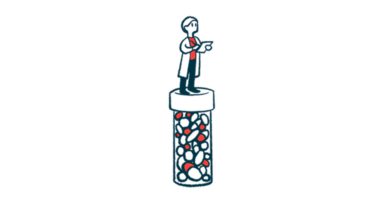MG flares affect sizable number of patients in US, despite treatment
Study finds exacerbations over 2 years in about one-third of of large group

Despite treatment, people with myasthenia gravis (MG) in the U.S. continue to experience exacerbations — episodes of disease worsening that may require urgent treatment and hospitalization — that carry high clinical and economic costs.
That’s according to a large retrospective analysis of claims data for patients with employer-based commercial insurance and on government-sponsored Medicare. It found at least one exacerbation in around one-third of these patients over two years of follow-up, with about half of this group having two or more flares.
“Novel therapies and personalized treatment approaches that may decrease MG exacerbations will be crucial to lower the clinical and economic burden of MG and increase patient quality of life,” the researchers wrote.
Findings from the analysis were reported in the study, “Healthcare resource utilization, costs and treatment associated with myasthenia gravis exacerbations among patients with myasthenia gravis in the USA: a retrospective analysis of claims data,” published in the Journal of Comparative Effectiveness Research.
Inadequate control of MG symptoms can lead to an exacerbation
MG is triggered by self-reactive antibodies that attack proteins required for the normal function of the neuromuscular junction, the site where nerve and muscle cells communicate to coordinate voluntary movements, leading to muscle weakness and fatigue.
Available MG treatments generally aim to help manage disease symptoms, by either suppressing the autoimmune response driving the disease or restoring nerve-muscle communication.
“However, owing to the fluctuating nature of MG, and limitations of current treatments that leave some patients with inadequately controlled symptoms, patients may experience exacerbations,” the authors wrote.
But data is limited “on the clinical and economic burden of exacerbations in patients with [MG],” they added. “Depending on insurance type, patients [in the U.S.] may have variable access to treatment and [healthcare resource utilization].”
Employees at Aetion and UCB Pharma conducted a retrospective analysis of claims data, from Jan. 1, 2008, through Sept. 30, 2019, covering adults in the U.S. with a confirmed MG diagnosis. Of note, Aetion is a data analysis company; UCB pharma markets two approved MG treatments, Rystiggo (rozanolixizumab-noli) and Zilbrysq (zilucoplan).
To be included in the analysis, patients had to show no sign of a disease exacerbation in the year before their MG diagnosis, and to have three years of continuous medical and pharmacy program enrollment. Patients were followed for two years after their diagnosis.
An MG exacerbation was defined in the study as any disease-related hospitalization, use of plasma exchange (plasmapheresis, given to remove self-reactive antibodies from circulating blood), or acute intravenous immunoglobulin use (five cycles or fewer in a 12-month period).
Flares more common in patients with comorbidities like anxiety or obesity
From a total of 9,352 identified patients, 3,218 had had at least one MG exacerbation during follow-up. Among them, around half (53%) had commercial insurance, 39.4% were on Medicare, and 7.6% had Medicaid. Because of its low number of patients, those with Medicaid coverage were excluded from further analyses.
Around a third of patients with commercial (31.9%) and Medicare insurance (37.1%) experienced at least one MG exacerbation during follow-up. Two or more exacerbations were reported in 52.5% of those with commercial insurance, and 44.8% of those on Medicare, with a higher mean number observed in those with commercial insurance compared with those on Medicare (3.7 vs. 2.7).
Regardless of insurance type, “anxiety disorders, depression, diabetes type I or II, infection, and obesity at baseline” were more common in patients who had one or more flares during follow-up than in those with no MG exacerbations, the study noted.
The mean time from diagnosis to a first exacerbation was somewhat longer for patients on Medicare than those with commercial insurance (225 vs. 203 days), as was the mean time between the first and second flare (185 vs. 141 days), as well as between the second and third flare (126 vs. 87 days).
After diagnosis and a first exacerbation, patients most commonly were treated with acetylcholinesterase inhibitors, which prevent the destruction of acetylcholine, a chemical messenger that instructs muscle cells to contract. Anti-inflammatory corticosteroids were the second most commonly used medication.
But with several exacerbations, use of intravenous immunoglobulin increased, a treatment that consists on administering antibodies from healthy donors to help neutralize and eliminate MG-driving antibodies. Plasma exchange use was low overall, the study noted.
Better and more effective treatment approaches needed, study says
Mean MG-related healthcare costs during these flares ranged from $26,078 to $51,120 for patients with commercial insurance, and between $19,903 to $49,967 for those with Medicare, mainly due to inpatient care.
The mean MG-related cost per exacerbation, in terms of the emergency department care, intensive care unit, and outpatient care, was higher for patients with commercial insurance than Medicare (mean of $39,079 vs. $33,446). Mean MG-related inpatient costs per exacerbation, however, were higher for patients with Medicare than commercial insurance (mean of $22,009 vs. $19,257 ).
“Despite conventional treatment, some patients with myasthenia gravis (MG) continue to experience disease exacerbations, suggesting an inconsistent clinical response to current treatment options,” the study noted.
“Approximately half of the cohort experienced at least two exacerbations during the 2-year follow-up, highlighting the need for new and effective treatment approaches that can reduce the clinical symptoms of patients with MG,” the authors concluded.
“There is an unmet need for improved, accessible treatment options for MG in the US,” they added, “especially treatment options that can reduce the likelihood of MG exacerbation and MG-related hospitalization, and subsequently improve patient quality of life.”





